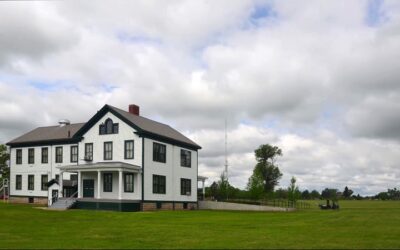“Power farming” with tractors furnishing the motion which for ages had been supplied to machines by the ox, the horse, or by other animals, began to make its presence felt in Nebraska in the early years of this century. This revolutionary turn of events can be researched in the newspaper files and in the archives of the Nebraska State Historical Society.
One such machine was the Square Turn tractor, built in the machine shops of A. T. Kenny and A. J. Colwell at Norfolk in 1914. The two inventors experimented in the shop and in the field until they had produced a one-man tractor that would turn short and square and would get close up to fence corners. It carried the plows below, in full view of the operator, and handled “as easily as a team.” An attachment that made many innovations possible was known as the Giant Grip Drive, a “new type of transmission never before used in any piece of machinery,” the inventors claimed. When Mr. Colwell conceived the idea of this new type of transmission, he was credited with having advanced the day when the horse would become obsolete as a draft animal. It overcame many objections which farmers had raised to other types of tractors. By installation of this powerful but simple transmission, they made it possible to do away with the clutch and differential gears. The tractor had far fewer parts than before thought possible, and every part was readily accessible to a mechanic.
The machine operated at the same speed and power in either direction, making a real “two-way tractor” which turned completely around in its own length and was said to handle as easily as horses or mules. There were no gears for the operator to shift and no clutch to bother with. Its manufacturers claimed also that it would work “around stumps, in orchards, and would clean up at the finish of a job even better than could be done with a team.” Other selling points were that it worked on hillsides too steep for a binder, on grades, and in low, wet places where most tractors could not be operated, and lifted its plows by power to clear trash or to turn corners.
By 1920 a factory had been installed in Norfolk to build the Square Turn Tractor. Main offices were in Chicago. The Square Turn was a three-wheel type having two traction or power wheels and one castor or free wheel. It would do the work of from 3 to 5 teams in general draw-bar work and would deliver 35 horsepower on the belt. A four-cylinder kerosene-gasoline Climax Tractor Motor with 510 cubic inches of displacement was used. The driver’s seat was swiveled and locked on the steering post. The Square Turn could be throttled down as low as _ mph or as high as 3 mph. Ninety percent of the 7,800-pound tractor’s weight was carried by the two large 50-inch diameter traction wheels. The spread of the traction wheels was 8 feet overall.
One farmer wrote from Neligh, “If you could see this tractor working over soft ground beside other makes, the reason for the large drive wheels in front would be plain to you. . . . I will say that the large drive wheels climb over soft ground and other obstructions instead of pushing themselves through as most other makes do.” Another man said, “We have surely given our Square Turn Tractor a test out this season. We filled a 14×90 pile with a 19-inch Ohio Monarch cutter in 4 l/2 days at this rate of about 14 tons per hour. That has been hard work for a steam engine, but we did it easily.”



